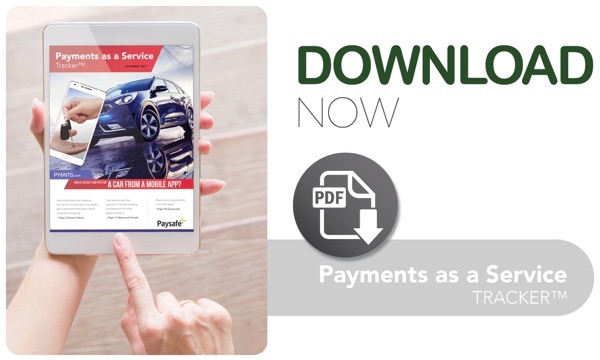Would You Buy (And Pay) For A Car From A Mobile App?

Talk about a U-turn. Bucking widely-held perceptions, studies show millennials are interested in owning cars after all. Now, Fair, a new mobile app, is delivering a millennial-first approach to car buying that allows the entire transaction to be completed via smartphone. In November’s Payments as a Service Tracker™, Fair CEO Scott Painter discusses the venture and the rapidly changing car buying behaviors. Plus, notable PaaS developments and more than 100 providers in the directory — including five new additions.
Some of the most notable recent changes to the automotive market include the rise of electric-only vehicles, advancements in autonomous vehicle technology, the growth of rideshare companies and built-in vehicle payment tools that enable motorists to use their wheels to pay for parking or gas. While some of these innovations are on the horizon and others are currently in place, it’s clear the automotive industry is camped in the disruptions fast lane and barreling toward a reinvention without taking a pit stop.
Even the ways consumers pay for their auto loans and leases are changing, thanks to new mobile-first solutions enabling consumers to browse nearby inventory. Car shopping marketplaces like Cars.com, TrueCar and AutoTrader allow them to browse for vehicles that match their budgets and needs at nearby dealerships, all from the comfort of their homes or mobile devices. In addition, these platforms promote dealers’ inventory to a wide audience.
Consumers might choose to visit their closest dealership once they find the right vehicle on a popular platform. This trip often involves haggling over prices and filling out paperwork, factors that can be a drain on the car shopping experience. But, a recently launched car shopping service for pre-owned vehicles aims to change that model by eliminating the negotiation process and enabling customers to complete the entire car shopping experience through a mobile app — including payment.
Car-shopping app Fair was launched in Los Angeles in September by Scott Painter, Fair founder and former CEO of TrueCar, with plans to expand to more markets in 2018. Painter said the service specifically targets millennial consumers by allowing them to shop for pre-owned vehicles based on the monthly payment amount for which they are pre-qualified.
PYMNTS.com recently caught up with Painter to discuss the service and the changes he anticipates will be coming to the automotive market — including the intertwined ramifications technology, business and vehicle ownership will have on one another as the space evolves.
A phone-first vehicle shopping tool
A consumer who downloads the Fair app can use it to snap a photo of his or her driver’s license to initiate a credit check. The app uses a series of application program interfaces (APIs) to run a soft pull credit check of a user’s information to determine income. From there, Fair determines a monthly budget the consumer can afford and presents a listing of vehicles at local dealerships that fall within that budget.
In addition to helping consumers find cars they can afford, the Fair app can also facilitate loan or lease payments to the dealership. Funds are electronically withdrawn from a consumer’s bank account with future payments made on a monthly basis. Available vehicles are certified pre-owned and include a warranty, standard maintenance and roadside assistance. Consumers have the option to pay for collision and liability insurance through the app, as well.
According to Painter, the platform is intended to remove the complexity and negotiations involved in the car shopping model by bringing the experience onto a mobile platform. He noted app customers can use their mobile phones to sign a payment agreement and even terminate the agreement early by giving the dealership a five-day notification.
“The goal is to create a subscription model for owning a vehicle,” Painter said.
The millennial factor
Fair’s phone-first approach to vehicle shopping was designed for millennials, he explained. The launch of the service comes at a time the demographic is beginning to challenge the commonly-held perception that their generation lacks interest in vehicle ownership.
A recent report by TransUnion found millennials are showing greater interest in auto loans than their counterparts from Generation X. It reviewed credit origination trends over a 12-month period for both generations and found millennials are opening auto loans at a higher rate — 14.58 percent compared to the 12.09 of Gen Xers. TransUnion also found millennials between 21 and 34 years old opened 21 percent more new auto loans than Gen X borrowers when its counterparts were in the same age bracket.
But, while the service was built for millennials, Painter thinks it has broader appeal because the service does not act as a money lender. Instead, it helps consumers determine the payments they can afford and connects them with appropriate vehicles and dealerships.
“It was built with the modern consumer in mind, the millennial buyer looking for a late model car,” Painter said. “We’re finding it’s working for everybody, because we’re not lending money [and] we’re more open to every credit profile.”
Kicking the pricing transparency tires
Having a platform that matches a consumer’s budget with the fair market value of a certified pre-owned vehicle adds a new level of transparency to the car-shopping process. It can also help consumers protect against potential losses from vehicle depreciation.
“For the last 100 years, [dealerships] have been forcing consumers to take all the risk by borrowing huge chunks of money to buy a depreciating asset, [and] they have no idea what it will be worth,” Painter said.
He added that data from the wholesale and retail market can paint a clearer picture of what a vehicle will be worth, thus helping Fair to offer consumers a fairer price.
“Today, we have near artificial intelligence-level clarity around what a vehicle is really worth,” Painter said.
And consumers aren’t the only ones Fair could benefit. Because it makes the purchase of the vehicle, Fair then delivers the payment to the dealership, expediting the exchange of money.
“For dealers, this is the most efficient way for them to get paid for the purchase of a car,” he explained.
Initial participation on the Fair app was available by invitation-only. According to Painter, more than 73 California-based dealership franchises have signed up for the service and have served “hundreds of customers” since it went live.
The changing automotive landscape
While the automotive world is buzzing about the dawn of autonomous vehicles and the impact they could have on everything from transportation regulation to infrastructure, Painter pointed out that broader consumer adoption of autonomous tech could take years to come to fruition.
“It’s going to take 40 to 50 years for autonomous vehicles to replace the existing fleet,” he said. That means there will be billions of non-autonomous vehicles available for consumers to purchase in the meantime.
Advancements in vehicle technology are not the only changes the automotive industry is facing, though. Rideshare services like Uber and Lyft have prompted consumers to examine whether vehicle ownership is even necessary. Meanwhile, companies like Tesla are bypassing the traditional dealership model by selling vehicles directly to consumers as technology products.
While these developments are disrupting the automotive market, Painter noted they are also encouraging it to reinvent the wheel and consider new business ideas. In fact, some customers want to buy or lease a vehicle for the purpose of driving for a rideshare service.
“It’s an exciting time to be in the car business, because there’s more willingness to rethink issues than there ever has been,” Painter said. “The rise of companies like Tesla and Uber have forced companies to think about what’s possible.”
While the possibilities of autonomous vehicles have consumers’ imaginations going into overdrive, these developments are several years away from reality. In the interim, consumers have a simpler way to shop and pay for non-autonomous, used vehicles.
. . . . . . . . . . . . . . . .
To download the November edition of the PYMNTS.com Payments as a Service Tracker™, click the button below.
About the Tracker
The PYMNTS.com Payments as a Service Tracker™ is designed to give an overview of the trends and activities of merchant platforms that not only enable payment processing of new and old technologies but also integrate with other features to improve the merchant’s experience — including customer engagement, security, omnichannel retail, analytics, inventory management, software and hardware management and more.

